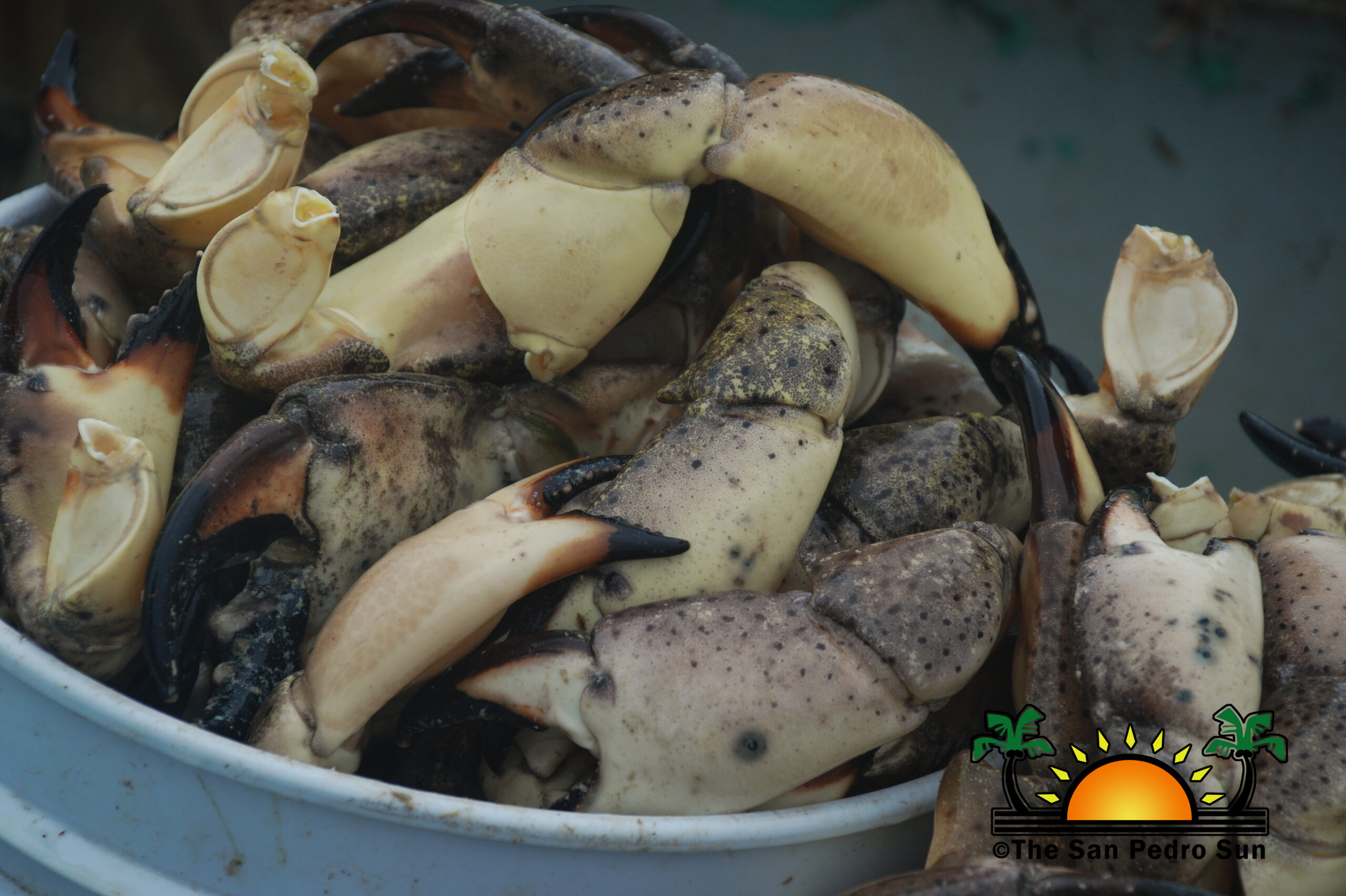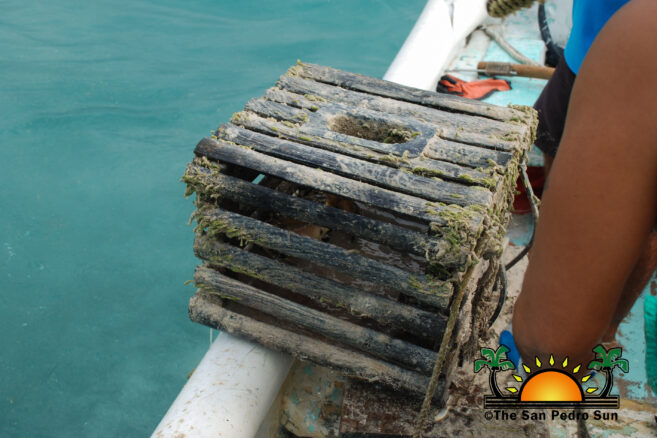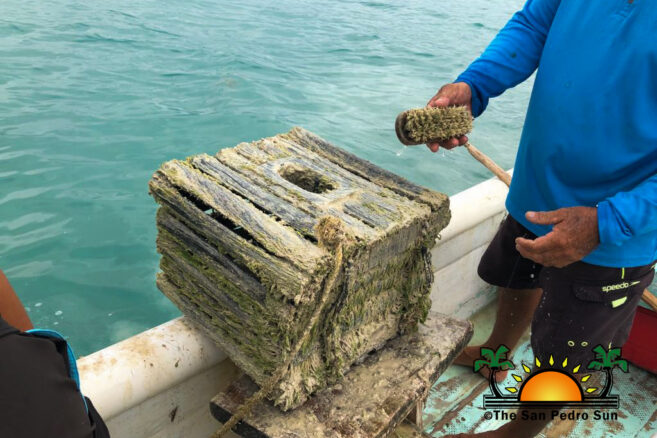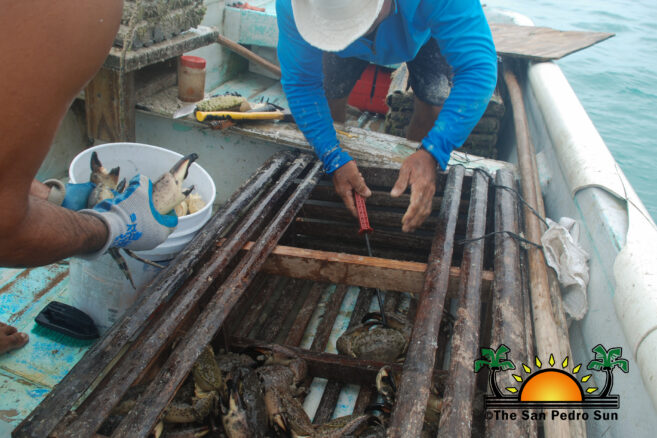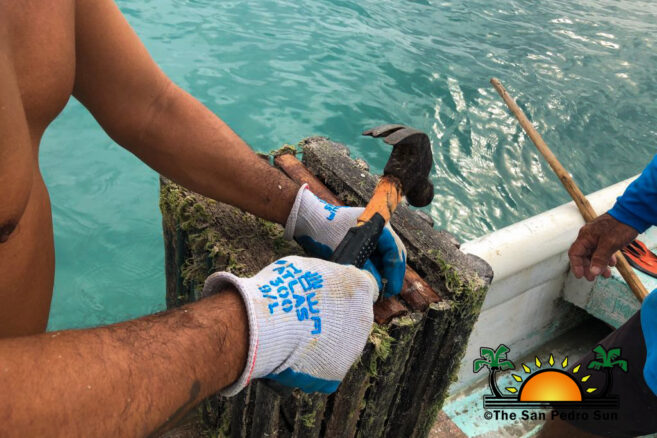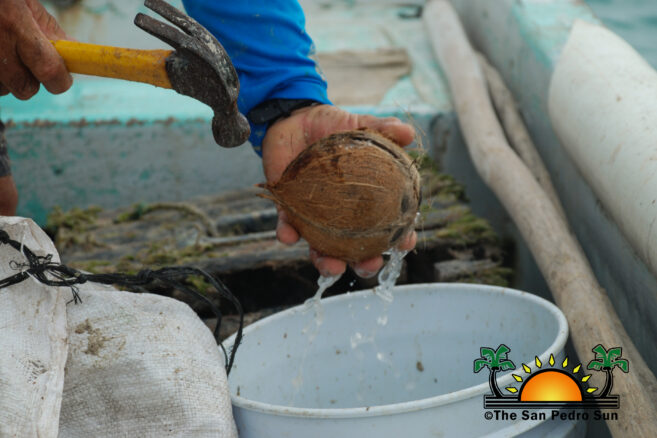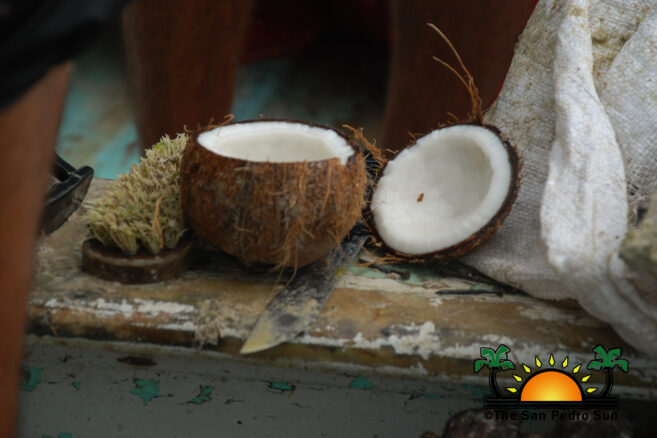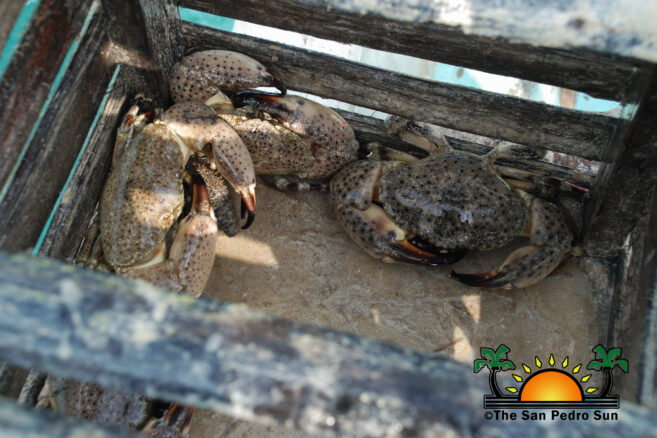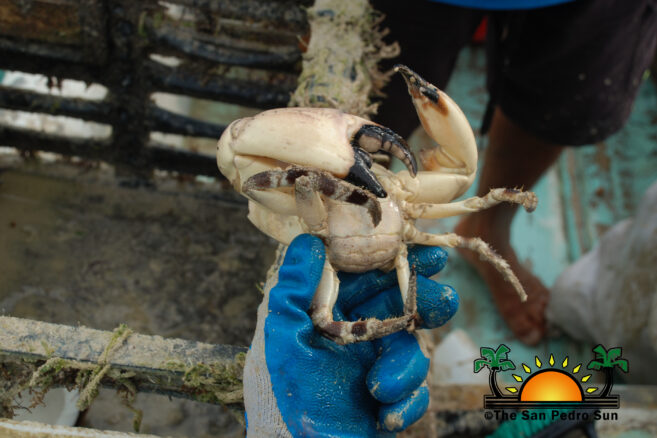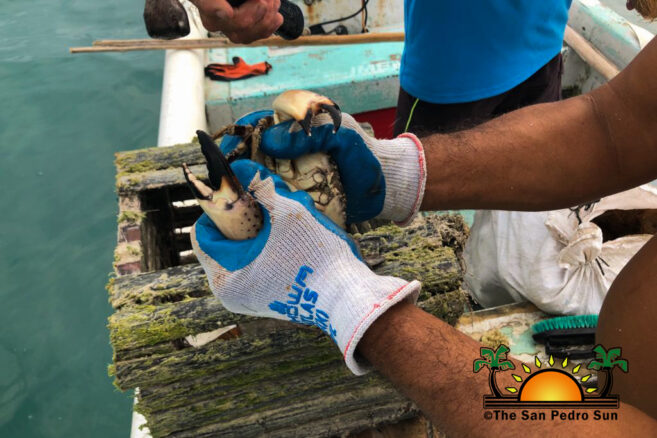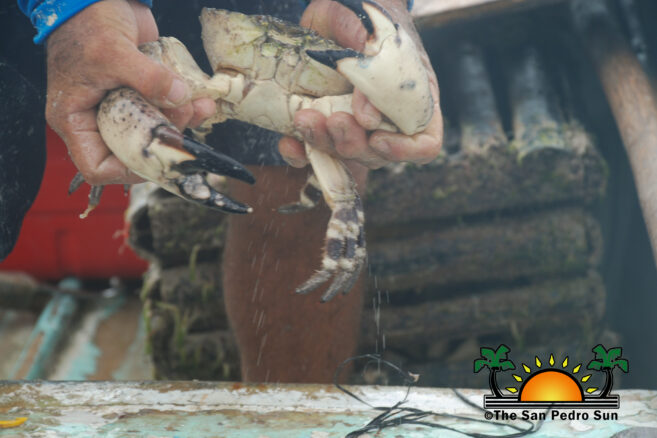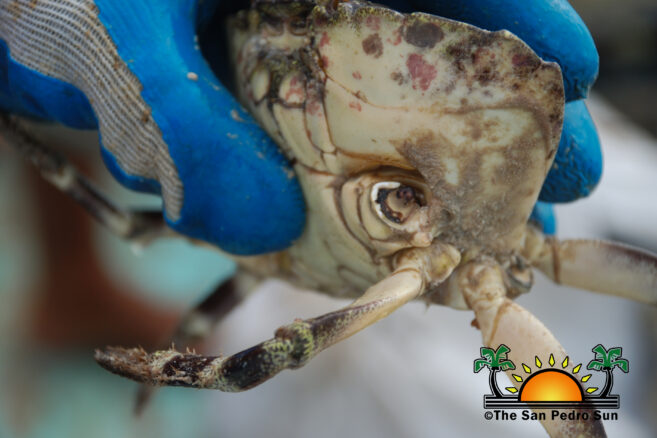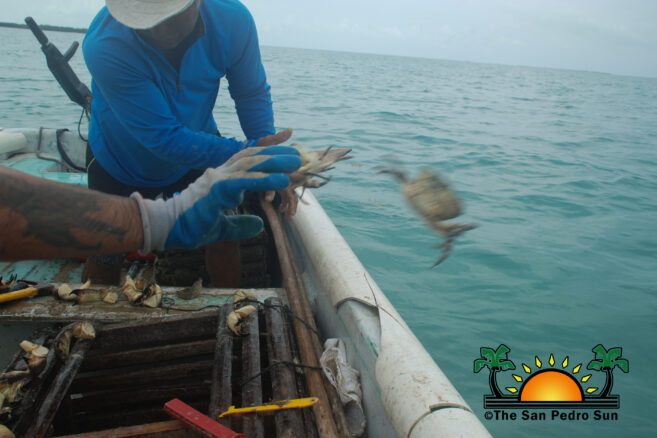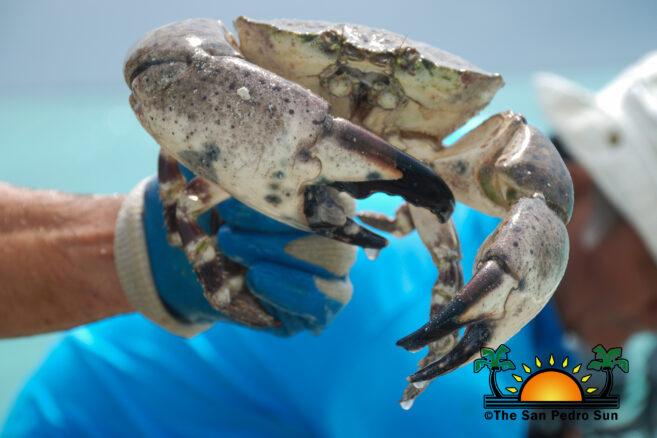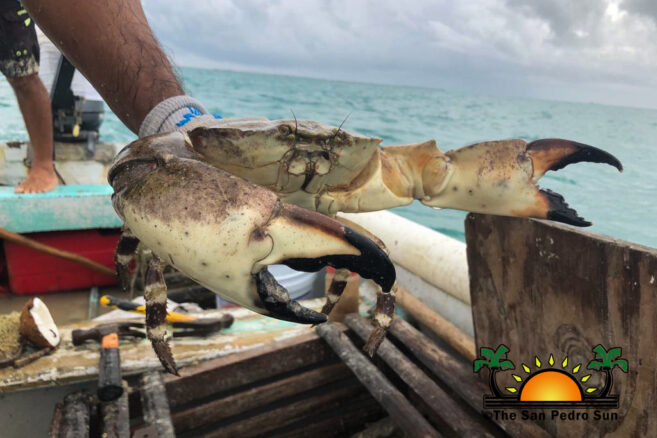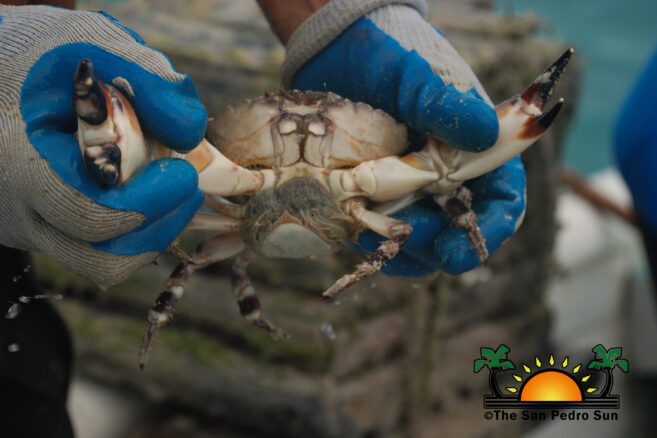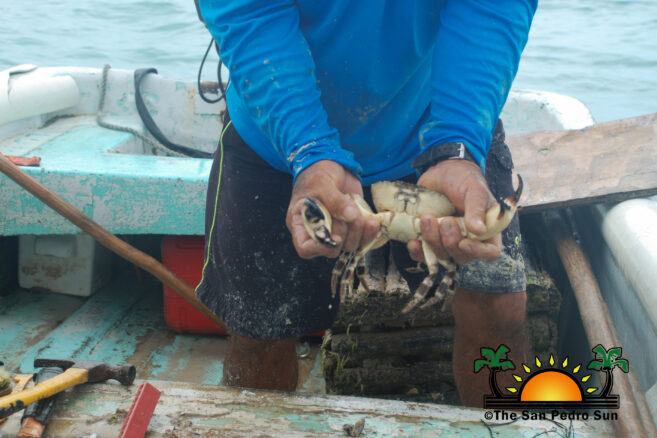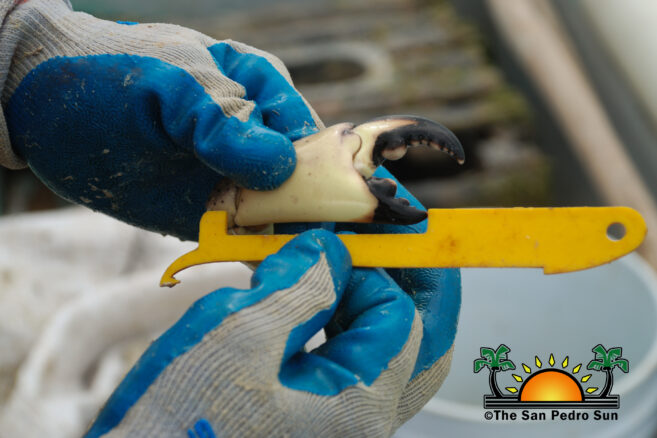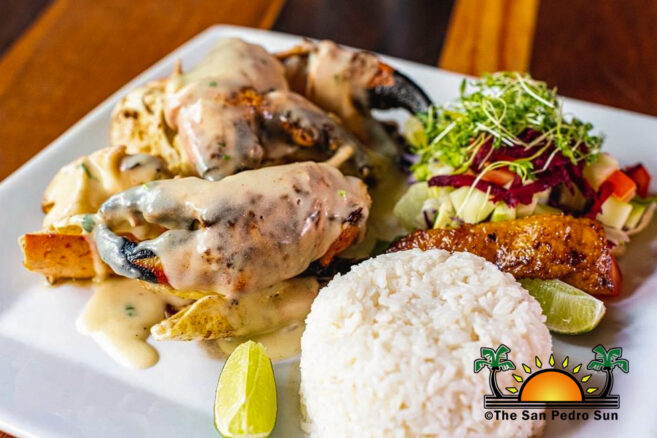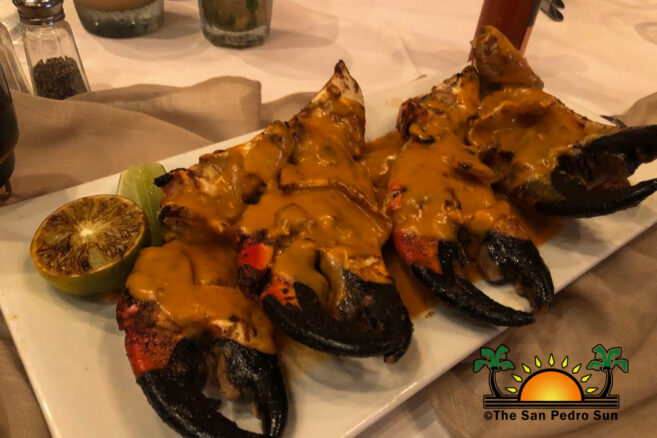Written by Dion Vansen
Edited by Tamara Sniffin
Veteran fisherman, Carlos Chan, is one of the few in Belize licensed to harvest stone crab claws and has been in the fishing business for decades. He shares that stone crabs have grown in popularity in Belize, and, as such, he dedicates his fishing time to the coveted crustacean, along with queen conch, lobster, and fish. Chan, who lives on the island of Caye Caulker off the northeastern Belizean coast, demonstrated how to declaw the crabs and the importance of sustainable fishing practices.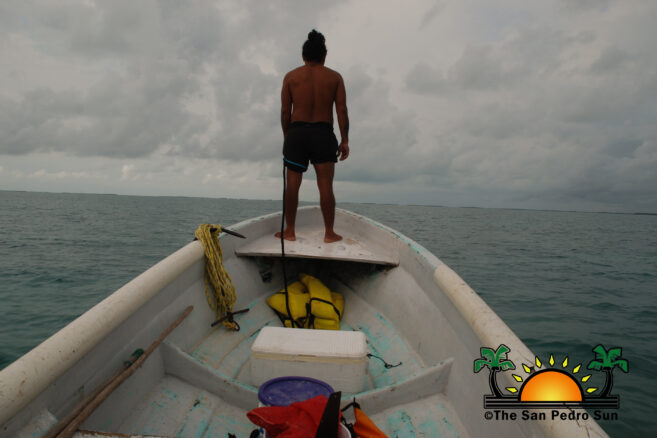
Early in the morning, Chan and his helper load his little panga (boat) with the necessary tools, crab traps (small boxes), storage vessels for the claws, water, and some food. Afterward, it’s time to head out to his fishing grounds some 30 minutes southwest of Caye Caulker. Chan explained that each licensed crab fisherman has designated fishing areas identified with themed buoys or sticks. These areas are essential for each fisherman to ensure a successful catch each visit.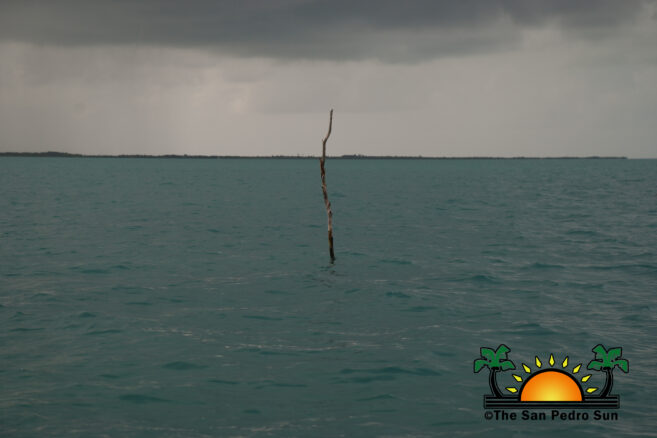
Although the day is somewhat overcast, Chan captains the boat to his fishing area without incident. While approaching the fishing grounds, he points to several sticks emerging from the water that mark his territory. Chan says that around these sticks, his traps are set. But how does he find them? “The traps are tethered to a small buoy via a rope. That’s how I find them,” he explains. With the help of a long stick, he hooks one of the floating rope loops, and up comes a small box with overgrown algae.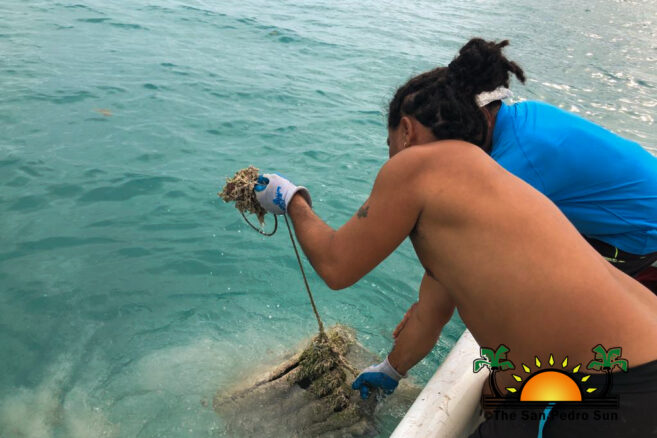
Chan and his helper start scrubbing off the algae, and after opening the trap, voila! There were a few stone crabs inside with huge claws. Chan measures the claws to ensure they are the correct size. It is illegal to harvest claws less than three inches long. Chan explained that violating this law can result in a BZ$1,000 fine and/or six months in prison. The Fisheries Department corroborated this, adding that licensed crab fishers will lose their license after a second offense.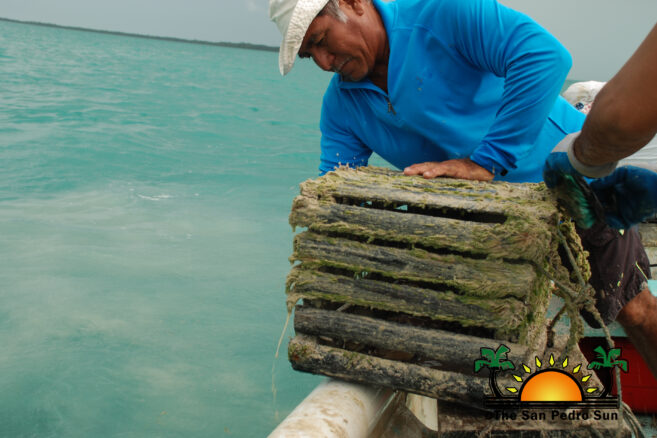
After assuring they are of legal size, Chan places the first crabs inside a large wooden box as the fishing continues. Most of the declawing occurs at the end of the fishing period. Before returning the trap to the water, Chan chops some coconuts and places them inside to attract the crabs, who love eating coconut meat. The crab trap will remain in the water for about two weeks. However, if the demand increases, Chan may pull them out of the water before that period.In the following hours, Chan maneuvers the boat in circles locating the traps and fetching them out of the water. Some have more crabs than others, others are empty, and some show signs in the wood where the crab has cut its way out. Chan has a hammer, boards, and nails to repair the damaged traps.
The fishing grounds are extensive, and they pause their fishing near midday after all the traps are checked. Now it is time to remove the claws, and we pay attention to the procedure.
Identifying and removing stone crab claws
Chan says to look for white bands around the legs to ensure it is a stone crab. The claw clipping starts after measuring each crab claw straight from the elbow to the tip. The skilled fisherman avoids breaking off the joint connecting the claw to the body, which can lead to ripped muscle and bleeding, resulting in another claw not growing back. Chan explains the proper way is never to twist the claw. “Break the claw down with a sharp and quick movement,” he says. “If you are not careful, the crab can be injured, and the claw may not grow back. The crab will not be able to defend or feed itself and will die. So, removing the claw with care is important,” Chen says. He stresses that they only remove the claws. Along with his worker, they demonstrate this technique with excellent skills in removing the claws and releasing the crabs back into the water. According to him, the claw grows back in one molting period, about a year, and can take up to three molting periods (or about three years) to grow to legal size. He added that younger crabs grow their claws faster than older ones. In some cases, both claws may be removed if they meet the legal size. However, Chan recommends leaving one claw so the crustacean can fend for itself and scavenge.
Some of the traps have a few females with eggs, so they were released immediately without removing their claws.
Delivering the product
With the fishing done, Chan returns home and weighs his catch of the day. On an average fishing trip, they catch around 300 crabs. The claws are sold by the pound. Among the different places purchasing claws include a few restaurants like Elvi’s Kitchen and Caramba in San Pedro, Ambergris Caye, which pay BZ$25 per pound. These restaurants stress the importance of working with licensed fishers. They work with designated crab fishers from whom they purchase the claws. Other clients, including fishing cooperatives, usually pay BZ$20 per pound.
Chan delivers his order to the local water taxi company to get his claws to San Pedro.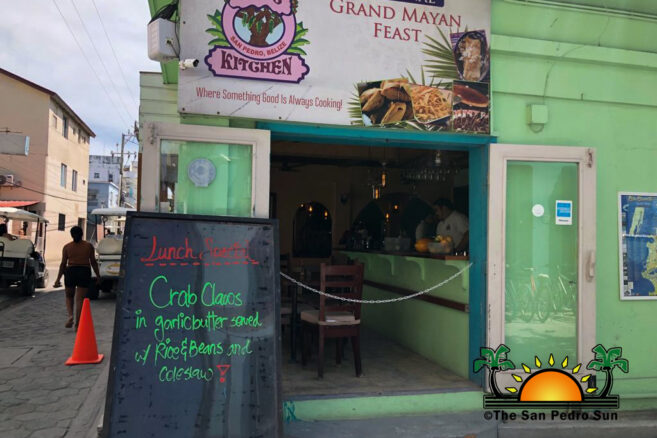
A delicacy in Belizean eateries
The stone crab’s claws have become a delicacy in gourmet restaurants with increasing demand in areas such as Ambergris Caye off the northeast coast of Belize. A plate containing 1 1/2lb of cooked stone crab claws sells for up to US$42.50. Most crab claw fans have shared that their favorite way to consume the claws is steamed with a garlic butter sauce and served with greens or sautéed vegetables. In other restaurants on Ambergris Caye, they prepare the claws in roasted garlic chipotle sauce. Tourists are the primary consumers of stone crab claws, and one couple shared that the price was worth it, knowing the great effort fishermen undergo to get these delicacies to their plates.
Advocating for sustainability
Chef Jennie Staines, a nationally renowned chef specializing in preparing stone crab claws, advocates for sustainable fishing. The kitchen boss at the iconic and well-known Elvi’s restaurant says she only buys from fishermen like Carlos Chan. According to her, some fishermen want to get into stone crab fishing but must familiarize themselves with the sustainable fishing method. This problem, combined with the absence of other regulations like a season, was taking a toll on the production of stone crab claws. Chef Staines shared that she reached out to the Ministry of Blue Economy after it was established in 2020, urging its Minister Andre Perez during a meeting at his office to take action as this new marine product was about to be exploited. According to Staines, Perez told her he would look into the matter and prepared an informative campaign with the Fisheries Department.
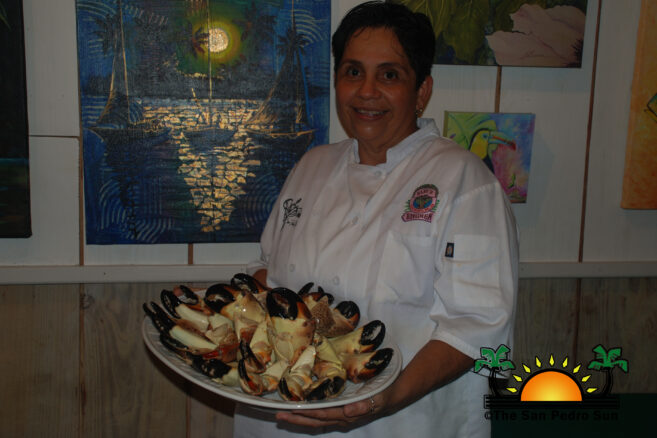
The government gets involved and establishes stone crab season
After several consultations and discussions with fisherfolks, a set of regulations regarding the harvesting of the Florida Stone Crab was introduced by the Belize Fisheries Department and the Ministry of Blue Economy on August 16, 2022, leading to an established fishing season for the Florida Stone Crab from October 1st through June 30th. To know more about this new regulation and the license application process, click here: https://shorturl.at/CIP16.
According to Belize Fisheries Department Capture Fisheries Unit Coordinator Kenneth Esquivel, the harvesting of stone crabs in Belize is minimal compared to lobster and queen conch. He explained that there are records of stone crab fisheries from the 1980s, which up to today, are stable. Esquivel said the production was only between 12,000 and 24,000 pounds yearly for the local market. Although they do not suspect a decline in the crab population in Belize, Esquivel noted that a season was necessary because they will start exporting the marine product this year. “That means that now the exploitation of the crab will increase due to the demand. So, now the crab fishers must satisfy the local demand and the export market. As such, we had to establish some management measures,” Esquivel said. We then established a season after consultations with fishers and conducting studies about places with similar stock. That place was in the Miami, Florida area, and based on their management criteria, we implemented our seasons and regulations here in Belize.” He explained that in the past and due to the small size of these new fisheries, it was managed informally without any guidance. This led to the harvesting of the entire crab, which led to its death. Today, with the regulations, only the claws can be harvested without killing the animal. Esquivel emphasized that the introduction of the season and rules were not because of a decline in the stone crab population (although there are no official records of the stock) but because they are expecting a significant increase in fishing efforts, thus the need to set up those regulations in place until a proper and comprehensive stock assessment is done.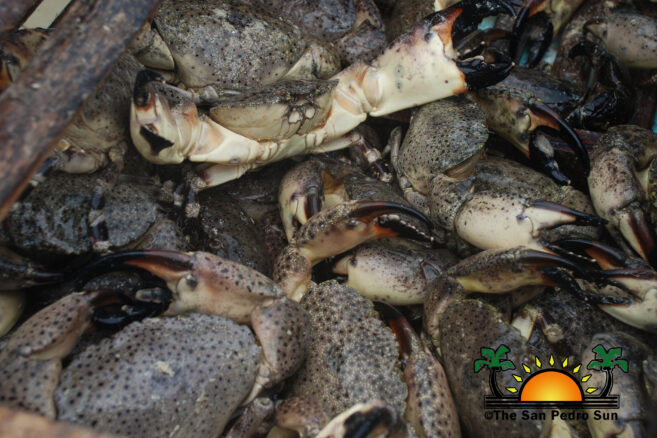
This new law to conserve and control the fishing of the Florida Stone Crab in Belize was welcomed by Staines and the current 16 licensed crab fishers in the country. Staines, Chan, and other fisherfolks advised others in the industry to abide by this new law. They asked other fishermen to be responsible. “It will be a win-win situation for conservation and the economic aspect of the tourism and fishing industry in Belize,” Staines noted. The Fisheries Department is issuing licenses to harvest stone crab claws only to traditional crab fishers to control this new marine product further. The process requires applicants to pay a fee of BZ$100 for the license, which is valid for one year. Other requirements that may be needed include a valid fisherman’s license and owning a licensed fishing vessel. The Fisheries Department indicates that additional information or documentation may be required to consider the application. The Department will make further announcements when non-traditional stone crab fishers can apply.
Belize’s Blue Economy
The extended Caribbean coast of Belize supports the livelihood of thousands. From prehistoric times to the arrival of the first Europeans, mainly British settlers, the territory’s blue space (seas) has provided plenty of opportunities derived from marine products such as fish, lobster, and conch, including shrimp and crabs.

Trading those hydrobiological products has led to practices that have spanned up to today. That is why with the introduction of Belize’s Blue Economy Ministry in 2020, headed by Minister Andre Perez, the government has focused on strengthening sustainable sea-based economies across the extended Belizean Caribbean coast. It is a complicated task as coastal developments continue to see detrimental activities such as dredging and clearing mangrove forests. One of those areas is San Pedro Town, Ambergris Caye, where significant tourism development and growth threatens mangrove and seagrass ecosystems. Most recently, development has led to the death of mangroves due to dredging and filling in the lagoon area near the airport. Perez has expressed that mangroves are vital, especially for fisheries and other natural resources like the Meso-American reef. However, he believes there should be a balance between conservation and development. “The blue economy says that we need to develop our coast. Growing our economy, the Gross Domestic Product is important, but something called balance defines the blue economy. Any investments like the development of a resort that requires that mangroves are cleared, the proper studies must be done,” Perez told the media.
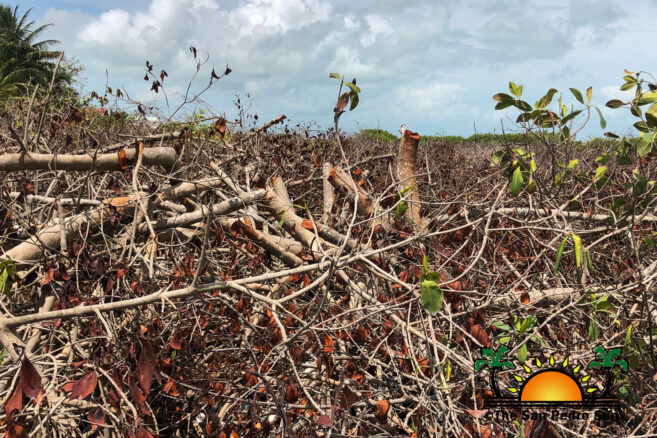
Even though this crucial ecosystem vital for the Blue Economy continues under threat, Perez said that his Ministry remains committed to the blue economy and tourism that provides jobs and foreign exchange earnings. As per the Belize Chamber of Commerce and Industry, tourism is the country’s first foreign exchange earner, with a contribution of over BZ$540 million annually. While earnings from marine products such as lobster and conch, the Statistical Institute of Belize reported an increase from BZ$33.3 million in 2021 to BZ$36.4 million in 2022.
One of the plans to further bolster the sustainable use of marine resources includes creating a development plan for deep sea fishing in the Exclusive Economic Zone to establish the Belize Sustainable Ocean Plan (BSOP). The BSOP campaign has been hosting community meetings across coastal communities, engaging fisher folks and other stakeholders to participate in the process to bolster biodiversity protection. One of the most critical topics is collectively determining the type of developments suitable for these protected assets.
Andre Perez also stated that while the current fisheries industry in Belize is primarily the harvesting of lobster, conch, and shrimp in nearshore marine waters, the Blue Economy Ministry continues to explore the possibility of diversifying fisheries through the sustainable use of marine species. One species that is becoming heavily commercialized, particularly within the tourism sector, is the Florida Stone Crab (Menippe mercenaria). This sea crab, widely caught for food, is typically found in the western North Atlantic. Its habitat includes the coasts of countries like Colombia, Jamaica, The Bahamas, Mexico, Belize, and parts of the United States like Texas. They have few predators, such as sea turtles, grouper, and octopus. It lives in shallow waters, sandy/muddy bottoms, and seagrass beds. According to Florida Fish and Wildlife Conservation Commission research, stone crabs feed on oysters, small mollusks, other crustaceans, and even seagrass and carrion. Females reach sexual maturity at about two years of age. According to the commission, the spawning season lasts all spring and summer. Females can lay up to a million eggs. The crab molts two or more times per year when they are juveniles, in contrast to adults, only shedding once yearly. They can regenerate lost claws or legs. This makes stone crab fishery unique as only the claws are harvested, and the animal is released alive. Artisan fisherfolks in this type of fishing say that this practice ensures ocean ecosystem health, supports their livelihoods, and drives economic growth.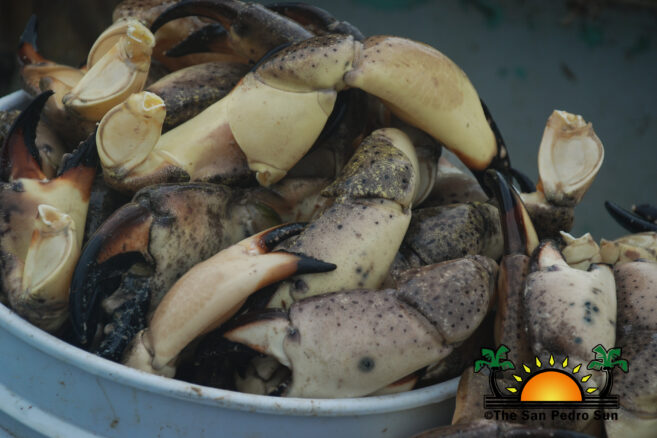
The value of the overall industry, as per the Belize Fisheries Department (BFD), was around $125,000 for the local market. However, this number is expected to increase as exporting stone crab claws to other markets in the United States and the Caribbean starts. The Department considers this fishery artisanal as they have a regulated number of licensed crab fishers registered. Even though there is no exact data on the population of stone crabs in Belize, the BFD noted no decline and no concerns regarding sustainability or overexploitation. Capture Fisheries Unit Coordinator Keneth Esquivel explained that to keep track of the crab’s stock. “We have management regulations serving as buffer zones, giving us time to conduct a comprehensive assessment. So, in the upcoming season, we will have baseline data on which we can move on and determine the abundance of this marine species,” said Esquivel.
Belize Fisheries Department stats on the Florida Stone Crab in the country
The Belize Fisheries Department shared that there is an allowable catch quota with the new season. According to information shared by Kenneth Esquivel, the quota for 2022-2023 is 20,000 lbs of crab claws. Esquivel explained that the fishing quota is divided between four producers, two of which are fishing cooperatives and the other two private companies. These include the Northern Fishermen Cooperative Society Ltd, National Fishermen Producers Cooperative Society Ltd, Feincatch Company Ltd, and Rainforest Seafood Ltd, based out of Jamaica. The only company that is starting to export claws is Rainforest Seafood Ltd. The other companies, Belizeans, focus more on lobster and queen conch. A representative from the other organizations briefly stated that they see higher demands for lobster and conch.
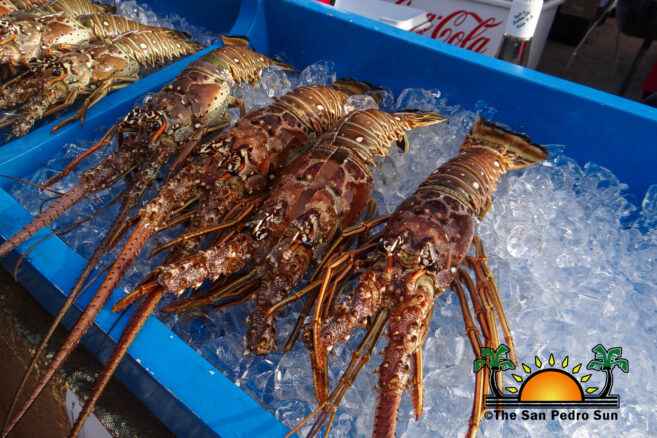
Each of these entities is allowed a 5,000 lbs fishing quota per season, and the companies met their quota long before the 2022-2023 season closes. To continue fishing after reaching their quota, they must apply for an extension from the Fisheries Department. Failure to do so will result in a fine determined at the time of the offense by the Department’s administrator. The only cooperative that sought an extension this year was Rainforest Seafood Ltd. A representative shared that, in contrast with the other fish companies, this was due to the high demand they experienced for stone crab claws.
What plans are there to safeguard marine assets?
To help the fishing industry thrive in a manner that future generations will be able to enjoy the benefits the Blue Economy has to offer, fishers and fishers’ organizations are encouraged to contact the National Fisheries Department at telephone number 224-4552 or by email at [email protected] to report any suspicious activities. The Department can also be contacted for any clarifications regarding the regulations. Esquivel stated there have been no reports of violating the rules. He explained that enforcement is very costly, and the Department does not have sufficient resources. However, they have personnel at the different marine reserves that work with rangers in protected areas. “We also collect data from landing sites to ensure that those fishers delivering products have a license. We inspect the product and ensure that the crab claws measure more than three inches per the regulation. That’s one way we monitor,” said Esquivel. He added that from time to time, they do patrols and rely on crab fishers, who protect the industry from any violators.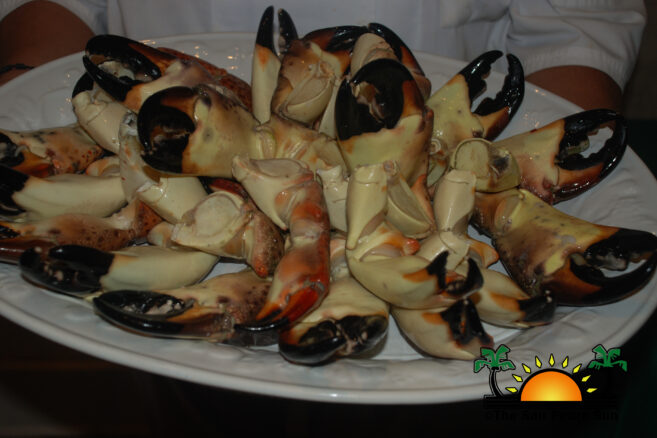
The Department advised that if a fisherman or consumer (restaurant) has crab product in large quantities and cannot get rid of it by the end of the grace period after the season closes, they can contact the Department to make further arrangements.
“This story is produced with support from Internews’ Earth Journalism Network.”

